
Sail Number: No. 3
Type: (Pilot Boat)
LOA: – LOD: 95’ 6″ / 29.10m – LWL: 81′0″ / 24.68m – Beam: 24′7″ / 7.49m – Draft: 10′2″ / 3.09m – Designer: – Original Owner(s): Pilots John McCulloch, Erskine, Mayo, Boyd, Meyer, Kautz, Matthew and Johnson – Year Launched: December 23, 1893 (11:00am) – Built By: Union Iron Works in San Francisco Bay – Hull Material: Wood – Displacement: 91.4 gross tons / 86.83 net tons – Former name(s) Gracie S – O.N. 86275 – Status: (November 1, 1963) – Lost off the southern tip of Rangiroa Island, 200 miles northeast of Tahiti
Historical:
Named after the daughter of sugar and shipping magnate John D. Spreckles, the Pilot Schooner GRACIE S was a San Francisco Pilot Association stalwart for more than 50 years. Christened by Miss Jessie Armager, granddaughter of Pilot Jones, and Miss Nellie Erskine and launched in 1893 out of the local Union Iron Works, – the only sailing vessel this famous builder of steel ships for the United States Navy and others ever built- her hull was painted white in 1897, echoing the look of Pilot Schooner AMERICA. GRACIE S would later become the second of the schooner fleet fitted with auxiliary power (120 hp Bolinder Oil Engine) in 1914.
Reduced Sail Area
As dependence was to be placed on power, the former large sail areas was no longer required, and consequently the gaff was removed from the mainsail, that sail being made jib-headed with a head iron, and the bowsprit was shortened, thereby doing away with one jib. Under sail it was found that the vessel handled much better than she did previously when she was heavily ballasted, and carried the larger sail area that was necessary when she had to get off shore in a heavy gale. It was also found that the propeller offered little resistance, for as soon as the vessel got under way, getting up to a speed of four or five knots, the propeller revolves and the resistance is not noticeable.
Under Sterling Hayden Stewardship
Early Hollywood years
Sterling was navigator on the Essex-built schooner Gertrude L. Thebaud under Captain Ben Pine in the hotly contested 1938 Fisherman’s Cup races v. the Canadian schooner Bluenose. When the time came to present the cup to the Bluenose crew, who won two out of the three races, the trophy turned up missing. The errant trophy finally resurfaced a few weeks later. It was found early on Halloween morning on the steps of the orphanage, New England Home for Little Wanderers. The matron of the orphanage was puzzled as she unwrapped the lovingly prepared package. Inside the basket, next to the swaddled glimming cup, was a bottle of cod liver oil and a poem scrawled on a piece of paper:
Here’s to Angus, good old sport,
Whose challenge sort of takes us short,
Give us a gale that blows at thirty,
And we’ll bet our shirts on little Gertie.
Partly due to the intense media coverage of those races, Sterling was discovered by the press: his photo in the Boston Post captioned “Thebaud Sailor Like Movie Idol” led to modeling opportunities in New York and a call from Paramount Pictures.

Sterling Hayden:
I was completely lost, ignorant, nervous. But the next thing I knew, Paramount made me a seven-year contract beginning at $250 a week, which was astronomical. I got my lovely old mother and bought a car, and we drove to California… I was so lost then I didn’t think to analyze it. I said, ‘This is nuts, but, damned, it’s pleasant.’ I had only one plan in mind: to get $5,000. I knew where there was a schooner, and then I’d haul ass.
In 1946 at age 30 Sterling Hayden bought Gracie S. for $7000, and renamed her Wanderer. Sterling sold her once and bought her back when fortunes turned.
By the 50s, Hayden was a reluctant movie star embroiled in a brutal custody battle with his ex-wife Betty. He decided that drastic action was called for. The following excerpts from Mandel’s book, Sterling Hayden’s Wars, provide some details:
After turning down several film opportunities, Hayden decided to act on his instincts. In March of 1958, he began to arrange his break from Hollywood. His first step was to take his schooner Wanderer, which he had repurchased on Christmas Day 1955, for $20,000, from Los Angeles to San Francisco. In June, he hired a first mate, Spike Africa, an unconventional free spirit not unlike Hayden.

Hayden had actually been contemplating the journey for two years. He would secure financial backing and then take a largely amateur crew and sail from California to Scandinavia, transiting the Panama Canal. They would film the entire voyage, capturing the flavor of the voyage and then break the film into segments suitable for television. He ran into a brick wall in his attempts to obtain financing for the voyage. He approached over eighty possible investors, but each one turned him down. “Why risk capital in such a venture,” he ruefully recalled, “when the sponsor and the network cried for blood and guts and sex?” Undaunted, he proceeded to begin to select a crew for the voyage.
In June of 1958, Hayden had placed an ad in the personal columns of the New York Times, San Francisco Chronicle, Territorial Enterprise, Saturday Review, and Christian Science Monitor. It read:
VOYAGE UNDER SAIL 100-ton ex-Pilot schooner sailing from San Francisco August 15 for Copenhagen Sept. 15, 1959. Need six active intelligent young men and women. Send details to Sterling Hayden, Box 655—Sausalito, California.
He received two thousand replies within a month of the ad’s appearance. In addition, several people just showed up at the pier, gear in hand and ready to go. Some of the applicants were real eccentrics not fit to take to sea with him. Most were just good people who, like Sterling Hayden, searched for adventure, loved the sea, and were genuine free spirits.
One of the respondents to Hayden’s ad was a nineteen-year-old college student named Dennis Powers. Powers was an art major and mentioned in his letter that his favorite authors were Herman Melville and Joseph Conrad. Shortly after that, Hayden contacted him and arranged a meeting in Hollywood. The interview, which lasted twenty minutes, went very well. Towards the end, Powers provided a detail that he thought would be the showstopper: He didn’t know anything about sailing. Unfazed, Hayden replied, “Well, you’ve read about it and for me that’s very important.” As they parted, Hayden told him he would be in touch. Almost immediately after that, Powers was delighted to receive a card from the actor, inviting him to come up to the San Francisco Bay Area to see the Wanderer.

Arriving in San Francisco later that month, Powers remained in awe of his new acquaintance. “I felt like Ishmael. I didn’t know anything and here I was meeting with Ahab!” There were already several other applicants working on the schooner, performing all the required nautical tasks such as painting and helping to properly maintain the decks. It soon became obvious that Hayden was using the interview process as a way of providing free labor to prepare the schooner for the long voyage.
Mandel goes on to detail Hayden’s frustrations with the custody fight and his attempts to obtain financing for his voyage. He finally received a last-minute advance of $10,000 from Republic Pictures, with the understanding that he was only planning to sail from Sausalito to Santa Barbara. Mandel continues:

He reported back aboard the schooner as the sun was starting to set. Prepare to get underway, he informed his crew. They were going to take their last voyage together—to Santa Barbara.
At 11 p.m. on January 18, 1959, Wanderer got underway with the four Hayden children aboard, allegedly for Santa Barbara, 310 miles south. Hayden guided the ship to a point just outside of the twelve-mile limit. There, he assembled the crew and made an announcement. They were not going to Santa Barbara; they were bound for Tahiti.
Explaining his reasons and concluding by saying, “This is what I want to do,” he then asked the crew for their input. As Dennis Powers recalled, “After all we had done together in preparation, were we going to say no?” As Hayden would recount to Parade magazine that summer, “There was a moment of silence, followed by a faint cheer.” Wanderer set a course west for Tahiti and Sterling Hayden, in violating the court injunction, became a fugitive from United States justice.
In a brief cable from Tahiti Hayden said: “My motivation? An ounce of freedom is worth a ton of gold.”
For the full story of this fantastic voyage, we recommend reading Wanderer or Mandel’s Sterling Hayden’s Wars.
Provenance (The Wall of Remembrance – The Owners, Crew & Notable Guest):
Owner/Guardian: (1893) – Claus Spreckels
Owner/Guardian: (1946) – Sterling Hayden
Owner/Guardian: (1946) – E. Edison Kennell, refitted as a sea-going school for lads
Nav instructor: (1949) – William Donley
Owner/Guardian: (1955) – Sterling Hayden on Christmas Day repurchased Wanderer for $20,000
Since its publication in 1963, Sterling Hayden’s autobiography, Wanderer, has been surrounded by controversy. The author was at the peak of his earning power as a movie star when he suddenly quit. He walked out on Hollywood, walked out of a shattered marriage, defied the courts, broke as an outlaw, set sail with his four children in the schooner Wanderer–bound for the South Seas. His attempt to escape launched his autobiography. It is the candid, sometimes painfully revealing confession of a man who scrutinized his every self-defeat and self-betrayal in the unblinking light of conscience
Comments
Dave Soderlund – April 14, 2021
I have a print of the hull and sail plan of Grace S on my wall. Spreckles was playing poker with King Kalakaua and Robert Louis Stevenson and said the King should have his own Hawai’in money. Claus was going to San Francisco and talked the King into giving him a large amount of Pounds, US $ … Claus went to the mint and had the face value of coins minted for a fraction of what the.King gave him. He pocketed the difference. Spreckles later fell out of favor with the King and returned to San Francisco. Spreckles Ville still is on the Island.of Maui.
